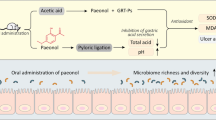Abstract
Antral ulcer may result from infection of Helicobacter pylori, duodenal bile reflux or gastritis. Several animal antral ulcer models were used to evaluate protection of drugs. Chemicals used to induce antral ulcer were diethyldithiocarbamate, indomethacin and strong acid solutions. Because these treatments produce damage of gastrointestinal tissues other than the antrum, most of these ulcer models cannot satisfactorily mimic the spontaneously occurring antral ulcer in human. Strong hydrochloride in refed rats also produce severe corpus lesions that might result from severe gastric oxidative stress. Oxyradical scavengers, including superoxide dismutase and allopurinol, improved antral ulcer healing. Other gastrointestinal drugs, such as prostaglandins, pirenzepine and lafutidine also were effective. Lysozyme, a mucolytic agent exerted remarkable inhibition of hemorrhagic antral and corpus ulcers in refed rats that had received strong hydrochloride. Mucolysate derived from the action of lysozyme produced elimination of gastric acid back-diffusion, which plays a pivotal role in gastric hemorrhage and antral ulceration.
Similar content being viewed by others
REFERENCES
Azuma, T., Dojyo, M., Ito, S., et al. (1999). Bile reflux due to disturbed gastric movement is a cause of spontaneous gastric ulcer in W/ Wv mice, Dig. Dis. Sci. 44, 1177–1183.
Chen, S. H., Pan, S., Okita, K., et al. (1993). Role of superoxide dismutase in mechanism of diethyldithiocarbamate-induced gastric antral ulcer in rats: Protective effect prostaglandin, cimetidine and pirenzepine, J. Gastroenterol. Hepatol. 8, 457–461.
Heikkila, R. E., Cabbat, F. S. and Cihen, G. (1976). In vivo inhibition of superoxide dismutase in mice by diethyldithiocarbamate,J. Biol. Chem. 241, 2182–2185.
Holzer, P., Pabst, M. A. and Lippe, I. (1989). Intragastric capsaicin protects against aspirin-induced lesion formation and bleeding in the rat gastric mucosa, Gastroenterology 96,1425–1433.
Hung, C. R. (2000). Importance of histamine, glutathione and oxyradicals in modulating gastric hemorrhagic ulcer in septic rats, Clin. Exp. Pharmacol. Physiol. 27, 306–312.
Hung, C. R. and Hsu, D. Z. (1998). Roles of histamine receptors and oxyradicals in aggravation of acid-induced gastric hemorrhagic ulcers in endotoxaemic rats, Inflammopharmacology 6, 339–355.
Hung, C. R. and Neu, S. L. (1997). Acid-induced gastric damage in rats is aggravated by starvation and prevented by several nutrients, J. Nutr. 127, 630–636.
Hung, C. R., Cheng, J. T. and Shih, C. S. (2000). Gastric mucosal damage induced by arecoline seizure in rats, Life Sci. 66, 2337–2349.
Kato, S., Takeuchi, K. and Okabe, S. (1993). Mechanism by which histamine increases gastric mucosal blood flow in the rat. Role of luminal HC, Dig. Dis. Sci. 38, 1224–1232.
Kuratani, K., Yamazaki, M., Kdama, H., et al. (1992). Possible involvement of hyperinsulinemia and activation in the pathogenesis of indomethacin-induced antral ulcers in nonfasted hamsters and rats, J. Pharmacol. Exp. Therap. 263, 951–955.
Kuratani, K., Kodama, H. and Yamaguchi, I. (1994). Enhancement of gastric mucosal blood flow by beta-3 adrenergic agonists prevents indomethacin-induced antral ulcer in the rat, J. Pharmacol. Exp. Therap. 270, 559–565.
McCarthy, C. J., Crofford, L. J., Greenson, J., et al. (1999). Cyclooxygenase-2 expression in gastric antral mucosa before and after eradication of Helicobacter pylori infection, Am. Coll. Gastroenterol. 94, 1218–1223.
Ohkawa, H., Ohishi, N. and Yagi, K. (1979). Assay for LPO in animal tissues by thiobarbituric acid reaction, Anal. Biochem. 95, 351–358.
Oka, S., Ogino, K., Hobara, T., et al. (1991). Effects of various mucosal protective drugs on diethyldithiocarbamate-induced antral ulcer in rats, Eur. J. Pharmacol. 197, 99–102.
Okabe, S. and Pfeiffer, C. J. (1972). Chronicity of acetic acid ulcer in the rat stomach, Am. J. Dig. Dis. 17, 619–629.
Onodera, S., Tanaka, M., Aoyama, M., et al. (1999). Antiulcer effect of lafutidine on indomethacin-induced gastric antral ulcers in refed rats, Jpn. J. Pharmacol. 80, 229–235.
Peskar, B. M. and Maricic, N. (1998). Role of prostaglandins in gastroprotection, Dig. Dis. Sci. 43, 23S–29S.
Satoh, H., Inada, I., Hirata, T., et al. (1981). Indomethacin produces gastric antral ulcers in the refed rat, Gastroenterology 81, 719–725.
Sava, G., Ceschia, V., Pacor, S., et al. (1993). Observations on the antimetastatic action of lysozyme in mice bearing Lewis lung carcinoma, Anticancer Res. 11, 1109–1113.
Takeuchi, K., Nishiwaki, H., Furukawa, O., et al. (1987). Cytoprotective action of histamine against 0.6 N HCl-induced gastric mucosal injury in rats; comparative study with adaptive cytoprotection induced by exogenous acid, Jpn. J. Pharmacol. 44, 335–344.
Uchida, M., Takayama, M., Kato, Y., et al. (1999). A novel method to produce extensive gastric antral ulcer in rats: Pharmacological factors involved in the etiology of antral ulceration, J. Physiol. (Paris) 93, 437–442.
Warzecha, Z., Dembinski, A., Brzozowski, T., et al. (2000). Gastroprotective effect of histamine and acid secretion on ammonia-induced gastric lesions in rats, Scand. J. Gastroenterol. 35, 916–924.
Rights and permissions
About this article
Cite this article
Hung, C.R. Experimental antral ulcer and several protective drugs. Inflammopharmacology 10, 375–384 (2002). https://doi.org/10.1163/156856002321544846
Issue Date:
DOI: https://doi.org/10.1163/156856002321544846




